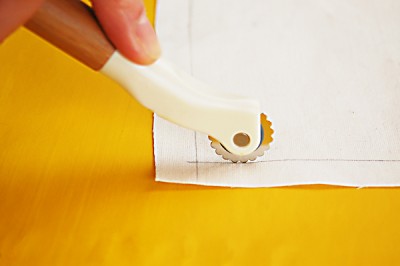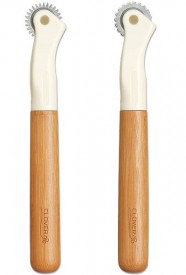If you’re using waxy carbon tracing paper, you’ll also need one or two different types of tracing wheels–a blunt-edged wheel or a serrated-edged wheel.
My two beloved (and expensive!) tracing wheels from design school died a few years ago, and when I tried to replace them I discovered that they aren’t made any more! This started a long, arduous hunt (I take my tools seriously) for good quality tracing wheels, which are surprisingly difficult to find.
Most of the wheels I found were wobbly, which makes it hard to trace a straight, smooth line. So I was especially glad when I found these new Clover wheels. I’m really pleased with them because they’re steady and smooth. And they’re pretty, too! (Much prettier than my expensive ones from school, in fact.)
You use the blunt- and the serrated-edged tools for different purposes. I’ll explain when you how you use each.
The blunt-edged, or smooth, tracing wheel is intended to be used with carbon transfer paper. It’s great for transferring markings onto paper or fabric, and it won’t damage the materials themselves. I use the smooth wheel and carbon paper to trace the Oliver + S patterns because I can trace and cut the size 5 while saving the original pattern sheet for later so I can make it again as S grows. When you use carbon transfer paper and a smooth tracing wheel you don’t need to buy special tracing paper, which can be expensive and difficult to find. Instead, use any sort of paper and position the carbon paper face down on top of the paper. Then tape the pattern sheet over of the layers and trace the size you need with the smooth tracing wheel. This will transfer the pattern lines to the paper with a nice, dark, legible line. It’s an easy, quick, and accurate method for tracing a pattern.

I use the serrated (or pointy) tracing wheel for two purposes. For thick or heavy fabrics (e.g., wool coatings, velvet, heavy canvas, etc.), it takes the place of the smooth tracing wheel when used with carbon paper because the bulk of the fabric can prevent the carbon from being transferred with the smooth wheel. But I mostly use it for tracing patterns without carbon paper.
To do this, you’ll need a self-healing cutting mat or a piece of cardboard (to prevent damage to your work surface). Lay the paper down on top of the cutting mat or cardboard and pin the pattern sheet on top. When you trace the lines with a serrated wheel, the points of the wheel push down through the paper layers, leaving a trail of tiny holes in the sheets. Once you have traced the lines, you can remove the pattern and true up the dotted lines on the bottom paper with a pencil, connecting them to re-draw the lines. It’s a little more time consuming than the carbon paper and smooth wheel, but it’s also really accurate and oddly satisfying. We use this method at the studio when we’re developing a pattern because the papers don’t shift and we can be sure the tracing is very precise.
These are four little tools. They are not very expensive, but they are surprisingly useful and relatively difficult to find. So we’re glad that we’re able to make them available to you.

No Comments yet.